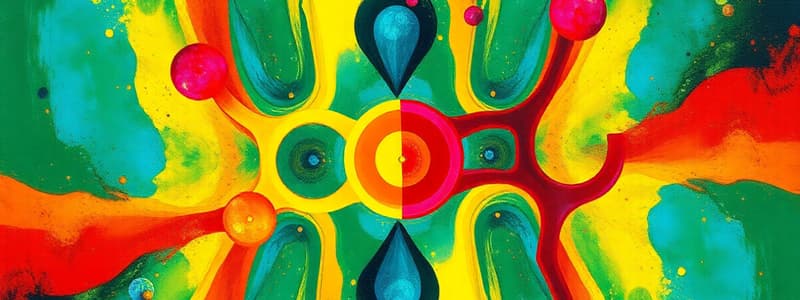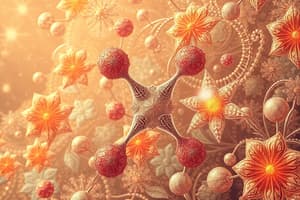Podcast
Questions and Answers
What defines a chiral centre in a molecule?
What defines a chiral centre in a molecule?
- A carbon atom bonded to three identical groups.
- A carbon atom that is connected to a double bond.
- A carbon atom with four different groups bonded to it. (correct)
- A carbon atom that has no bonds with hydrogen.
What are enantiomers?
What are enantiomers?
- Isomers that differ in the arrangement of atoms but not bonds.
- Optical isomers that are mirror images of each other. (correct)
- Isomers that rotate plane polarized light in the same direction.
- Molecules that have the same structural formula.
What occurs in a racemic mixture?
What occurs in a racemic mixture?
- It consists of only one enantiomer.
- It is formed from a symmetrical carbon.
- It rotates polarized light in one direction.
- It has a 1:1 ratio of two different enantiomers. (correct)
How do nucleophilic addition reactions lead to the formation of optical isomers?
How do nucleophilic addition reactions lead to the formation of optical isomers?
What is the effect of enantiomers on plane polarized light?
What is the effect of enantiomers on plane polarized light?
Which statement about optical isomers is correct?
Which statement about optical isomers is correct?
What is the overall effect of a racemic mixture on polarized light?
What is the overall effect of a racemic mixture on polarized light?
How can the presence of a chiral centre in a molecule be indicated?
How can the presence of a chiral centre in a molecule be indicated?
Flashcards are hidden until you start studying
Study Notes
Optical Isomers
- Optical isomerism is a type of stereoisomerism where molecules have the same molecular formula but a different spatial arrangement of atoms.
- Optical isomers occur when there is an asymmetrical carbon within an organic molecule known as a chiral centre.
- A chiral centre is a carbon atom with four different groups bonded around it so there is no line of symmetry to the molecule.
Enantiomers
- The presence of a chiral centre leads to the presence of two possible isomers that are mirror images of each other.
- These are optical isomers, also known as enantiomers.
- Enantiomers are unique because they have different effects on plane polarised light.
- Each enantiomer rotates plane polarised light by 90 degrees in opposite directions.
Racemic Mixtures
- A racemate is formed when optical isomers are produced as a pair of enantiomers in a 1:1 ratio.
- The opposite directions of rotation of the enantiomers in a racemic mixture cancel each other out, making the mixture optically inactive.
- Racemic mixtures are formed as a result of nucleophilic addition reactions.
Nucleophilic Addition Reactions
- Nucleophiles can attack a molecule with a carbonyl group from above or below the carbon-oxygen double bond.
- This produces two possible products that are mirror images, and therefore optical isomers.
Studying That Suits You
Use AI to generate personalized quizzes and flashcards to suit your learning preferences.



